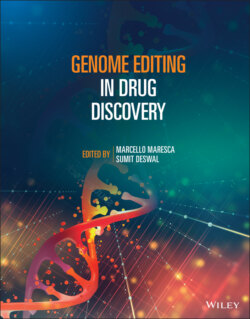Читать книгу Genome Editing in Drug Discovery - Группа авторов - Страница 54
4.1 Introduction
ОглавлениеCRISPR genome editing technologies provide versatile tools for the genetic manipulation and screening of genes and pathways in mammalian cells and in model animals. Their applications in drug discovery are broad, including target discovery, target validation, mechanism of action, and target engagement studies (Lu et al. 2017). Since first described, many improvements and novel applications of the technology have been reported. The technologies include gene knock out (KO) via non‐homologous end joining (NHEJ) following CRISPR‐mediated double‐stranded break (DSB), gene knock in (KI) for SNP/mutation generation or gene insertion/gene tagging via homology‐directed repair (HDR) of DSB, and transcriptional or epigenetic regulation via fusion of an inactivated CRISPR Cas protein (“endonuclease dead” dCas9) with a transcriptional activator (CRISPR activation, CRISPRa) for upregulation of gene expression, with a transcriptional repressor (CRISPR interference, CRISPRi) for downregulation of gene expression, or with an epigenetic modifying enzyme (CRISPRepi) for DNA methylation or post‐translational modifications of histone proteins. While these platforms were largely developed by academic labs, their rapid implementation in biomedical and pharmaceutical research settings has been greatly facilitated by reagent providers and contract research organizations (CROs) that offer state‐of‐the‐art reagents and contract services. In fact, it is now routine practice for scientists to use commercially available CRISPR reagents for in‐house studies and/or to consider working with a CRO on a specific genome editing project. This article aims to summarize our learnings and provide guidance on the selection of appropriate reagents and/or CROs for CRISPR‐based studies.
